Navigation
Water and Sanitation Related Diseases and the Environment: Challenges, Interventions and Preventive Measures
- Agriculture
- Amazon
- anthropogenic sources of water pollution
- anti-biotic resistant bacteria
- chemical pollutants
- child survival
- controlling water pollutants
- demography
- dengue
- disease prevention
- drought
- ecosystem services
- geographic distribution of disease vectors
- Global climate change
- guinea worm disease
- HCWH water
- health care
- household water treatment and safe storage
- HUdson River
- human rights
- HWTS
- hygiene
- infectious diarrhea
- kinship
- malaria
- malnutrition
- MDG
- mercury
- Mexico
- naturally occurring water pollutants
- nutrition
- ocean pollution
- onchocerciasis
- PCBs
- sanitation
- Schistosomiasis
- shigellosis
- soil-transmitted helminths
- success sanitation projects
- toxic cyanobacteria
- trachoma
- UN Millennium Development Goals
- undernutrition
- water crisis
- water services
- Desertification
- Global Climate Change
- Global Health
- News and Special Reports
- Oceans, Coral Reefs
- Pollution
- Population
- Public Health
- Sanitation
- Toxic Chemicals
- Water
- Water and Sanitation
The drought and famine once again blighting the Horn of Africa brings with it an unwelcome reminder that for all of mankind’s achievements we are yet to eradicate the scourge of poverty or to provide clean water, sanitation or basic health care for the world’s most desperate people.
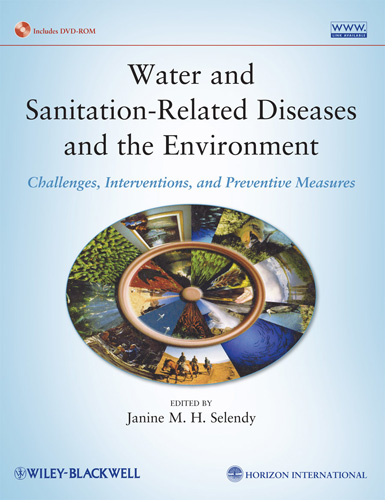
“The book is certainly an excellent resource for anyone interested in health in developing countries. Best wishes with the next steps on the supplementary material and all your efforts.” (Wafaie Fawzi, Richard Saltonstall Professor of Population Sciences, and Professor of Nutrition, Epidemiology, and Global Health, and Chair, Department of Global Health and Population, Harvard School of Public Health, 28 September 2012)
The Second Volume, Water and Sanitation-Related Diseases and the Changing Environment: Challenges, Interventions, and Preventive Measures is now available. It is also a Wiley-Blackwell collaboration with Horizon International.
The drought and famine once again blighting the Horn of Africa brings with it an unwelcome reminder that for all of mankind’s achievements we are yet to eradicate the scourge of poverty or to provide clean water, sanitation or basic health care for the world’s most desperate people.
In her new title, Water and Sanitation Related Diseases and the Environment: Challenges, Interventions and Preventive Measures, Janine Selendy explores the close relationship between sanitation, clean water supply and the environment to outline strategies for the prevention and eradication of water and sanitation-related diseases.
Written by 59 experts from the fields of public health, medicine, epidemiology, environmental health, climate change, environmental engineering, and population research, this authoritative volume provides an understanding of the interconnection among many factors linked to water related diseases, sanitation, and hygiene. It is brought together by Selendy who founded Horizon International, a non-profit organisation based at Yale University, in 1976.
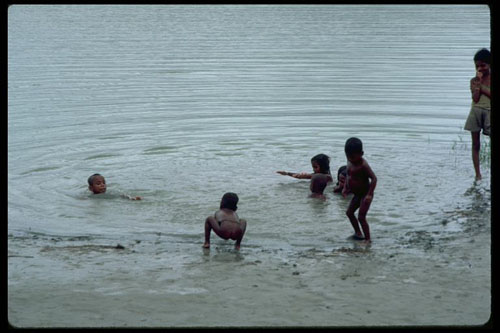 Children playing in pond in Bangladesh. Defecating in water is a frequent cause of disease transmission.: Shigellosis, the archetype of a disease resulting from poor personal and environmental hygiene and sanitation, causes an estimated more than 1,000,000 deaths a year. It was the second most common cause of diarrhea among U.S. military personnel during the recent Iraq war. From Michael L. Bennish and M. John Albert, “Shigellosis,” chapter in "Water and Sanitation Related Diseases and the Environment: Challenges, Interventions and Preventive Measures."
Children playing in pond in Bangladesh. Defecating in water is a frequent cause of disease transmission.: Shigellosis, the archetype of a disease resulting from poor personal and environmental hygiene and sanitation, causes an estimated more than 1,000,000 deaths a year. It was the second most common cause of diarrhea among U.S. military personnel during the recent Iraq war. From Michael L. Bennish and M. John Albert, “Shigellosis,” chapter in "Water and Sanitation Related Diseases and the Environment: Challenges, Interventions and Preventive Measures."
This book presents the conditions responsible for water and sanitation related diseases, the pathogens and their biology, the morbidity and mortality resulting from lack of safe water and sanitation, the distribution of these diseases, and the conditions that must be met to reduce or eradicate them.
“Meeting water and sanitation needs, coupled with protection of the environment and prevention of pollutants, is essential to every effort to improve the health and living conditions of billions of people,” said Selendy.
“Meeting these needs is fundamental, not only to effectively diminish incidence of diseases that afflict a third or more of the people of the world, but also to improve education and economic well-being and elevate billions of individuals out of vicious cycles of poverty.”
The publication covers access to and the maintenance of clean water, and includes guidelines for the safe use of wastewater, excreta and greywater along with examples of solutions; this is presented with an emphasis on what is actually achievable in the real world, considering that 2.6 billion individuals have no toilets and 1.2 billion people are exposed to water-related illness from their drinking water.
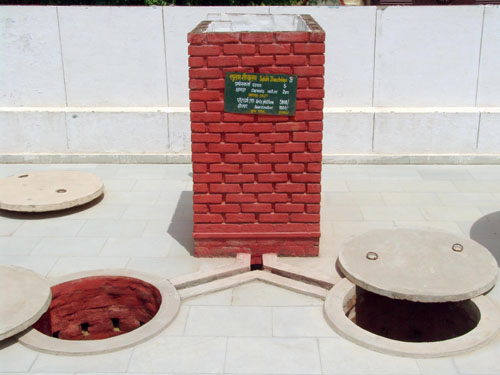 The Sulabh twin-pit, pour-flush, compost toilet - a simple solution to achieve the Millennium Development Goal on Sanitation: In India, the Sulabh Organization has built more than 1.2 million two-pit pour-flush toilets that are eco-friendly, technologically appropriate, socio-culturally acceptable, and affordable. Photograph courtesy of Dr. Bindeshwar Pathak, Sulabh International Service Organization.
The Sulabh twin-pit, pour-flush, compost toilet - a simple solution to achieve the Millennium Development Goal on Sanitation: In India, the Sulabh Organization has built more than 1.2 million two-pit pour-flush toilets that are eco-friendly, technologically appropriate, socio-culturally acceptable, and affordable. Photograph courtesy of Dr. Bindeshwar Pathak, Sulabh International Service Organization.
 Sulabh Organization has built over 7,000 pay-for use public toilet complexes with bathrooms, lockers,: and private toilets that treat wastewater, and produce biogas for agriculture and horticulture. Combined these facilities serve more than 10 million people daily. Photograph courtesy of Dr. Bindeshwar Pathak, Sulabh International Service Organization.
Sulabh Organization has built over 7,000 pay-for use public toilet complexes with bathrooms, lockers,: and private toilets that treat wastewater, and produce biogas for agriculture and horticulture. Combined these facilities serve more than 10 million people daily. Photograph courtesy of Dr. Bindeshwar Pathak, Sulabh International Service Organization.
“Horizon seeks to find and advance solutions thereby supporting ideas and initiatives that aim to inform and inspire positive action. We use peer-reviewed science and case studies from affected areas to examine interrelated issues including the environment and public health,” said Selendy. “The comprehensive chapters in Water and Sanitation Related Diseases and the Environment reveal the interdisciplinary approach which is essential to finding answers to some of the world’s most urgent problems.”
Divided into eight comprehensive sections that address the concerns from an international perspective, this volume covers:
The significance of the close relationships among water access and quality, lack of adequate sanitation and hygiene, and the relationship of human activity to the diseases
- Means of accessing clean water and preventing contamination of water
- The range of sanitation and hygiene measures available to reduce disease
- The broad extent, variety, and ramifications of environmental factors
- Ameliorating conditions and preventive measures to reduce pollutants found in ground and surface waters
- The adverse health impacts of water pollution, dam construction, irrigation development, and flood control
- Preventive measures and innovative, successful solutions are presented throughout, as well as featured in more detail in a special section at the end of the book. This section highlights examples from a diversity of locations in both developed and developing countries, focusing on what has been achieved in the control of water related diseases—and what can be done if the multi-factorial approach in this book is followed.
The accompanying DVDs, as well as a related websites, augment this vital information by means of case studies and articles, providing guidance for possible action on local and national as well as international levels.
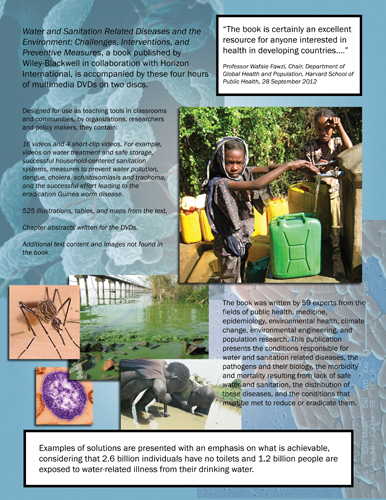 DVDs Descriptive flyer with book's Table of ContentsClick here to see the flyer about the DVDs content or click on image.
DVDs Descriptive flyer with book's Table of ContentsClick here to see the flyer about the DVDs content or click on image.
Guinea Worm's Last Stand: Southern Sudan
The book’s DVDs were designed for use as teaching tools in classrooms and communities, by organizations, researchers and policy makers. They contain 16 videos and 4 short-clip videos. For example, videos on water treatment and safe storage, successful household-centered sanitation systems, measures to prevent water pollution, dengue, cholera, schistosomiasis and trachoma, and the successful effort leading to the eradication Guinea worm disease. They also contain 525 illustrations, tables, and maps from the text, chapter abstracts written specifically for the DVDs, and text content and images not found in the book.
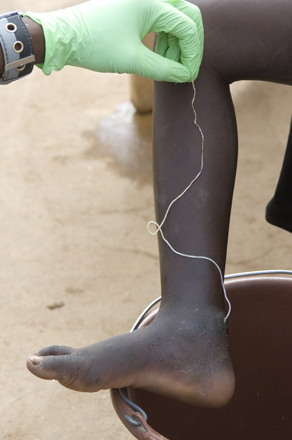 Emerging guinea worm: Guinea worm is a disease “which is propagated by infected humans washing or bathing in water, allowing the guinea worm to release its larvae that are then consumed by tiny water fleas. The flea-infested water, when consumed by humans, introduces the guinea worm larvae into a new host.” From chapter "Dracunculiasis (Guinea Worm Disease): Case Study of the Effort to Eradicate Guinea Worm," by Donald R. Hopkins and Ernesto Ruiz-Tiben
Emerging guinea worm: Guinea worm is a disease “which is propagated by infected humans washing or bathing in water, allowing the guinea worm to release its larvae that are then consumed by tiny water fleas. The flea-infested water, when consumed by humans, introduces the guinea worm larvae into a new host.” From chapter "Dracunculiasis (Guinea Worm Disease): Case Study of the Effort to Eradicate Guinea Worm," by Donald R. Hopkins and Ernesto Ruiz-Tiben
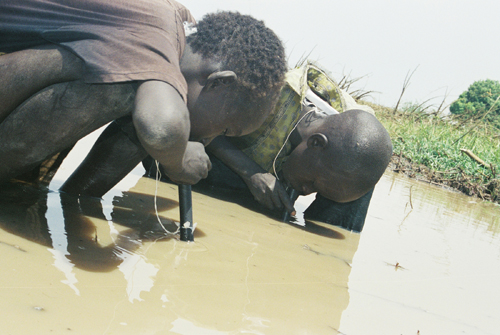 Portable pipe filters. “Since 1986 the Carter Center has been leading the campaign, community by community,: to eradicate the disease. Initially 20 countries had an estimated 3.5 million cases. Today, the disease is poised to become the second human disease, after smallpox, to be wiped out and the first to be eradicated without the use of a vaccine or medical treatment.” In November 2013, there were less than 600 reported cases. Photograph courtesy The Carter Center/Emily Staub
Portable pipe filters. “Since 1986 the Carter Center has been leading the campaign, community by community,: to eradicate the disease. Initially 20 countries had an estimated 3.5 million cases. Today, the disease is poised to become the second human disease, after smallpox, to be wiped out and the first to be eradicated without the use of a vaccine or medical treatment.” In November 2013, there were less than 600 reported cases. Photograph courtesy The Carter Center/Emily Staub
"The preventive measures and solutions presented here provide guidance for possible action on the local, national and international levels,” concluded Selendy. “The problems of water quality and related diseases are international and they are complex, but the research represented here demonstrates how collaborative science can help us unravel the complex and build a better world.”
Reviews:
“The book is certainly an excellent resource for anyone interested in health in developing countries. Best wishes with the next steps on the supplementary material and all your efforts.” (Wafaie Fawzi, Richard Saltonstall Professor of Population Sciences, and Professor of Nutrition, Epidemiology, and Global Health, and Chair, Department of Global Health and Population, Harvard School of Public Health, 28 September 2012).
"In 2010, the United Nations recognised the human right to water and sanitation. This was a major achievement and a huge step forward in the fight to prevent waterborne disease. Janine Selendy has produced a critical tool to help us take the next step forward in understanding the nature and causes of water and sanitation related diseases and in finding real solutions. The human right to water and sanitation is only as good as its implementation. This book leads the way." (Maude Barlow, Senior advisor on water to the 63rd President of the United Nations General Assembly 2008-09, January 2012)
"This book will promote integrated studies/research on water, sanitation-related diseases and the environment and will contribute to theoretical and practical respects of interventions and preventive measures, and therefore lead to a better life quality - for millions." (Yaqian Zhao, 2011 Centre for Water Resources Research, University College Dublin, 1 December 2011)
“This is a truly interdisciplinary book and reflects really well the need to work across scientific boundaries, and I think shows what can be achieved through collaboration.” (Society for General Microbiology, 15 May 2012)
"Written by experts from the fields of public health, medicine, epidemiology, environmental health, climate change, environmental engineering, and population research, this authoritative volume provides a thorough understanding of the interconnection among many factors linked to water related diseases, sanitation, and hygiene." (Miss Eco Glam, 1 October 2011)
“Congratulations on your book. This is a wonderful achievement and I am sure will encourage students to enter the field of global environmental health.” (Michael H. Merson, M.D., Founding Director, Duke Global Health Institute, Wolfgang Joklik Professor of Global Health, and Professor of Medicine, Community and Family Medicine, and Public Policy at Duke University and Vice Chancellor for Duke-National University of Singapore.)
“Great Resource: This book is an excellent compilation of papers by authoritative authors on crucial environmental issues today. As the author of one chapter, I may be a bit biased, but I can say without equivocation that the authors of the other chapters have written excellent summaries of the environmental issues they address. Janine Selendy, editor of this volume, has done a masterful job of planning this volume and putting it together. Congratulations to her on a job well-done. This is a valuable book for anyone wishing to obtain an overview of today's environmental issues.” (Edward Dodge, M.D., M.P.H., Visiting Lecturer, Faculty of Health Sciences, Africa University, Mutare, Zimbabwe and Courtesy Clinical Associate Professor, Department of Community Health and Family Medicine, University of Florida College of Medicine)
“Valuable Contribution: In order to responsibly use and protect this vast resource it is imperative to understand and appreciate the array of issues involved. This book provides a comprehensive view of all of the aspects regarding the earth's water supply. Janine Selendy has put together an excellent collection of pieces covering these topics exploring them in depth. I gained a great deal of insight into a variety subjects that I was not very familiar with prior to reading this book. It is an honor to be included as an author with such an impressive group of people. (Gretchen Welfinger-Smith, M.S. Institute for Health and the Environment, School of Public Health, State University at Albany)
“…it is wonderful how much you have included and how valuable this should be to people working in so many disciplines. And I loved your DVDs---great stories and well produced. Most of all, I think people all over the world will be able to relate to them.” (David Ellis, Ph.D., President Emeritus, Museum of Science, Boston )
The following is an Editorial Review posted by Barnes and Noble:
From The Critics
Reviewer: J. Thomas Pierce, MBBS PhD (Navy Environmental Health Center)
Description: This comprehensive book advises treatment of conditions responsible for water and sanitation-related diseases. It details responsible pathogens and accompanying morbidity and mortality attending poor water supplies.
Purpose: For reasons that somewhat escape explanation, many students of public health actually begin to embrace the discipline with enthusiasm through the water and sanitation course they are required to complete. This is absolutely the best book in terms of imparting this enthusiasm and technically explaining the delicate relationship that exists between peoples and their water sources.
Audience: "It is hard to put limits on the applicability and importance of this book. Its editor believes it is an essential resource for graduate students and postdoctoral scholars as well as professionals. I'm going to add business and community leaders to the list. The book belongs on the bookshelf of every NGO or parent organization that hopes to improve lives around the globe."
Features: Organized in eight sections, the book defines a global problem, connects water and sanitation-related diseases, examines available water resources, explains sanitation and hygiene, examines environmental factors, describes current and future trends in preventing pollution, highlights emerging issues, and offers a conclusions section outlining use of kinship structures. Included with the book are two DVDs that incorporate 16 full-length videos and various short clips, illustrations, and other materials.
Assessment: Few books could claim a title as broad and embracing as this one. It posits a way forward for the cornerstone for global development. It is a primer for organizations as diverse as the World Bank, the United Nations, and the U.S. Agency for International Development. However sobering, it is worth any concerned person's time.
Updates and additional resources are posted on a companion website: www.wiley.com/go/selendy/water and on the Horizon Solutions Site: www.solutionssite.org.
The publication is available from many sources including directly from Wiley at: http://www.wiley.com/WileyCDA/WileyTitle/productCd-0470527854.html.
Wiley provides a chance to read an excerpt:
Also available as e-books
ISBN: 978-0-470-52785-6
Wiley offers special prices for bulk sales and greatly reduced prices for purchases of the book in developing countries. The information is available “Request Pricing for Special Sales.”
Notes:
About the Author:
Janine Selendy is Co-Chair, Founder, and Publisher of Horizon International, a non-profit organization based at Yale University, which addresses health, environment and disease issues worldwide. She also serves as principal editor and publisher of Horizon's web-based Solutions Site and oceans and coral reefs site. She is executive producer of more than 20 television documentaries, many of which have won awards including a Cine-Golden Engle and have been broadcast in many countries. This publication originated from a syllabus on water and sanitation she prepared at the invitation of Yale School of Public Health which was the basis of subsequent lectures she gave at both Yale and at the Columbia Mailman School of Public Health. She is a generalist whose early medical work included a discovery while doing cancer research and co-authoring a paper for the Journal of Diabetes. Her background in medical, scientific, environmental and other areas provides her with an appreciation of the interconnectedness of many subjects.
About Wiley-Blackwell:
Wiley-Blackwell is the international scientific, technical, medical and scholarly publishing business of John Wiley & Sons, with strengths in every major academic and professional field and partnerships with many of the world’s leading societies. Wiley-Blackwell publishes over 1,500 peer-reviewed journals as well as 1,500+ new books annually in print and online, as well as databases, major reference works and laboratory protocols. For more information, please visit www.wiley.com
The Carter Center has posted PDFs of four chapters from the book along with the Wiley flier for the book on its website at http://www.cartercenter.org/news/publications/health/experts.html.
See the related article on the Horizon International website: Jan 05, 2012 Britain to Help Carter Center Secure Worldwide Eradication of Worm Disease
Search
Latest articles
Agriculture
- World Water Week: Healthy ecosystems essential to human health: from coronavirus to malnutrition Online session Wednesday 24 August 17:00-18:20
- World Water Week: Healthy ecosystems essential to human health: from coronavirus to malnutrition Online session Wednesday 24 August 17:00-18:20
Air Pollution
- "Water and Sanitation-Related Diseases and the Changing Environment: Challenges, Interventions, and Preventive Measures" Volume 2 Is Now Available
- Global Innovation Exchange Co-Created by Horizon International, USAID, Bill and Melinda Gates Foundation and Others
Biodiversity
- It is time for international mobilization against climate change
- World Water Week: Healthy ecosystems essential to human health: from coronavirus to malnutrition Online session Wednesday 24 August 17:00-18:20
Desertification
- World Water Week: Healthy ecosystems essential to human health: from coronavirus to malnutrition Online session Wednesday 24 August 17:00-18:20
- UN Food Systems Summit Receives Over 1,200 Ideas to Help Meet Sustainable Development Goals
Endangered Species
- Mangrove Action Project Collaborates to Restore and Preserve Mangrove Ecosystems
- Coral Research in Palau offers a “Glimmer of Hope”
Energy
- Global Innovation Exchange Co-Created by Horizon International, USAID, Bill and Melinda Gates Foundation and Others
- Wildlife Preservation in Southeast Nova Scotia
Exhibits
- Global Innovation Exchange Co-Created by Horizon International, USAID, Bill and Melinda Gates Foundation and Others
- Coral Reefs
Forests
- NASA Satellites Reveal Major Shifts in Global Freshwater Updated June 2020
- Global Innovation Exchange Co-Created by Horizon International, USAID, Bill and Melinda Gates Foundation and Others
Global Climate Change
- It is time for international mobilization against climate change
- It is time for international mobilization against climate change
Global Health
- World Water Week: Healthy ecosystems essential to human health: from coronavirus to malnutrition Online session Wednesday 24 August 17:00-18:20
- More than 400 schoolgirls, family and teachers rescued from Afghanistan by small coalition
Industry
- "Water and Sanitation-Related Diseases and the Changing Environment: Challenges, Interventions, and Preventive Measures" Volume 2 Is Now Available
- Global Innovation Exchange Co-Created by Horizon International, USAID, Bill and Melinda Gates Foundation and Others
Natural Disaster Relief
- STOP ATTACKS ON HEALTH CARE IN UKRAINE
- Global Innovation Exchange Co-Created by Horizon International, USAID, Bill and Melinda Gates Foundation and Others
News and Special Reports
- World Water Week: Healthy ecosystems essential to human health: from coronavirus to malnutrition Online session Wednesday 24 August 17:00-18:20
- STOP ATTACKS ON HEALTH CARE IN UKRAINE
Oceans, Coral Reefs
- World Water Week: Healthy ecosystems essential to human health: from coronavirus to malnutrition Online session Wednesday 24 August 17:00-18:20
- Mangrove Action Project Collaborates to Restore and Preserve Mangrove Ecosystems
Pollution
- Zakaria Ouedraogo of Burkina Faso Produces Film “Nzoue Fiyen: Water Not Drinkable”
- "Water and Sanitation-Related Diseases and the Changing Environment: Challenges, Interventions, and Preventive Measures" Volume 2 Is Now Available
Population
- "Water and Sanitation-Related Diseases and the Changing Environment: Challenges, Interventions, and Preventive Measures" Volume 2 Is Now Available
- "Water and Sanitation-Related Diseases and the Changing Environment: Challenges, Interventions, and Preventive Measures" Volume 2 Is Now Available
Public Health
- Honouring the visionary behind India’s sanitation revolution
- Honouring the visionary behind India’s sanitation revolution
Rivers
- World Water Week: Healthy ecosystems essential to human health: from coronavirus to malnutrition Online session Wednesday 24 August 17:00-18:20
- Mangrove Action Project Collaborates to Restore and Preserve Mangrove Ecosystems
Sanitation
- Honouring the visionary behind India’s sanitation revolution
- Honouring the visionary behind India’s sanitation revolution
Toxic Chemicals
- "Water and Sanitation-Related Diseases and the Changing Environment: Challenges, Interventions, and Preventive Measures" Volume 2 Is Now Available
- Actions to Prevent Polluted Drinking Water in the United States
Transportation
- "Water and Sanitation-Related Diseases and the Changing Environment: Challenges, Interventions, and Preventive Measures" Volume 2 Is Now Available
- Urbanization Provides Opportunities for Transition to a Green Economy, Says New Report
Waste Management
- Honouring the visionary behind India’s sanitation revolution
- Honouring the visionary behind India’s sanitation revolution
Water
- Honouring the visionary behind India’s sanitation revolution
- Honouring the visionary behind India’s sanitation revolution
Water and Sanitation
- Honouring the visionary behind India’s sanitation revolution
- Honouring the visionary behind India’s sanitation revolution

